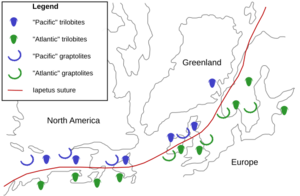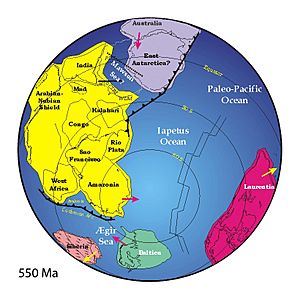Iapetus Ocean facts for kids


The Iapetus Ocean was a huge ancient ocean that existed a very, very long time ago. It was around during the Neoproterozoic and Palaeozoic eras, which means roughly between 600 and 400 million years ago. This ocean was located in the southern part of the world.
It lay between three large landmasses, or continents, that were separate at the time. The Iapetus Ocean eventually closed up and disappeared when these three continents slowly moved together. When they joined, they formed one giant landmass. This supercontinent is often called Laurussia or Euramerica, because it was basically like North America and Europe stuck together.
The Iapetus Ocean was like an early version of the Atlantic Ocean. It was located where the Atlantic Ocean is now, but millions of years before the Atlantic even began to form.
How We Know About the Iapetus Ocean
Scientists found out about the Iapetus Ocean by studying ancient fossils and rocks. In the early 1800s, an American scientist named Charles Doolittle Walcott noticed something interesting. He studied tiny sea creatures called trilobites that lived on the seafloor.
Walcott found that the trilobites on one side of a certain line were very different from those on the other side. For example, trilobites found in Scotland and western Newfoundland were different from those found in the southern British Isles and eastern Newfoundland. This line where the differences appeared was later called the Iapetus Suture.
At first, geologists thought a deep valley or trough separated these areas. But in the 1960s, a new idea called plate tectonics became popular. This idea explains how Earth's outer layer is made of huge plates that are always moving.
Using plate tectonics, geologists realized that an ocean must have existed between these landmasses before the supercontinent Pangaea formed. This ancient ocean, the Iapetus, closed up as the continents collided. The place where they joined is what we now call the Iapetus Suture.
Where the Ocean Closed: The Iapetus Suture
The Iapetus Suture is the line where the Iapetus Ocean used to be. It marks the place where the ancient continents collided and joined together. You can still see signs of this suture in different parts of the world today:
- In Great Britain, the suture runs mostly along the border between England and Scotland. On the east, it goes through Lindisfarne, and on the west, it passes through the Solway Firth.
- On the Isle of Man, you can see a part of the suture at the Niarbyl Fault. It's a visible section of where the ancient continents met.
- In Ireland, the suture stretches from the east coast at Clogherhead in County Louth to the River Shannon estuary on the west coast.
- In Canada, the suture runs through Newfoundland and New Brunswick.
- In the United States, it goes through the northeastern states like Maine, New Hampshire, Massachusetts, and Connecticut.
While other suture lines exist from different continental collisions, the Iapetus Suture is one of the most important ones. It shows us where a huge ancient ocean once existed before the continents came together to form Pangaea.
See also
 In Spanish: Océano de Jápeto para niños
In Spanish: Océano de Jápeto para niños



